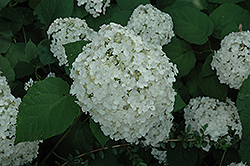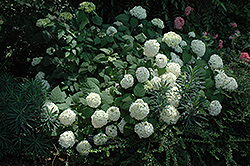It's all about ...
plants

Balsam Hydrangea
Hydrangea arborescens 'Balsam'
Height: 4 feet
Spread: 4 feet
Sunlight:
![]()
![]()
Hardiness Zone: 4a
Description:
This attractive selection features elegant lacecap white flower heads in mid summer, lasting for a very long time; best if treated like a perennial and pruned to a few inches from the ground in spring, blooms on new growth
Ornamental Features
Balsam Hydrangea features bold white lacecap flowers with creamy white overtones at the ends of the branches from mid to late summer. The flowers are excellent for cutting. It has forest green deciduous foliage. The heart-shaped leaves do not develop any appreciable fall colour.
Landscape Attributes
Balsam Hydrangea is a multi-stemmed deciduous shrub with a more or less rounded form. Its strikingly bold and coarse texture can be very effective in a balanced landscape composition.
This shrub will require occasional maintenance and upkeep, and is best pruned in late winter once the threat of extreme cold has passed. It has no significant negative characteristics.
Balsam Hydrangea is recommended for the following landscape applications;
- Mass Planting
- General Garden Use
- Naturalizing And Woodland Gardens
Planting & Growing
Balsam Hydrangea will grow to be about 4 feet tall at maturity, with a spread of 4 feet. It tends to be a little leggy, with a typical clearance of 1 foot from the ground. It grows at a fast rate, and under ideal conditions can be expected to live for approximately 20 years.
This shrub does best in partial shade to shade. It prefers to grow in average to moist conditions, and shouldn't be allowed to dry out. It is not particular as to soil type, but has a definite preference for acidic soils. It is highly tolerant of urban pollution and will even thrive in inner city environments. Consider applying a thick mulch around the root zone in winter to protect it in exposed locations or colder microclimates. This is a selection of a native North American species.
This plant is not reliably hardy in our region, and certain restrictions may apply; contact the store for more information.

